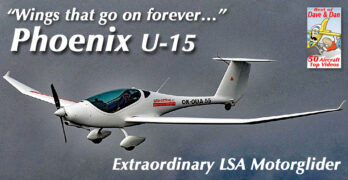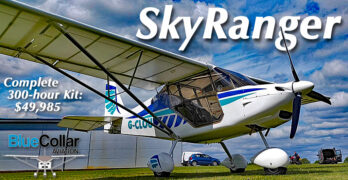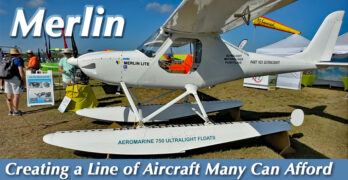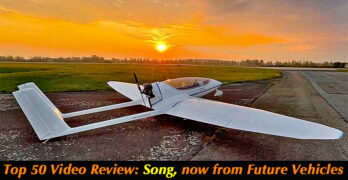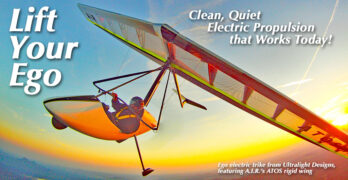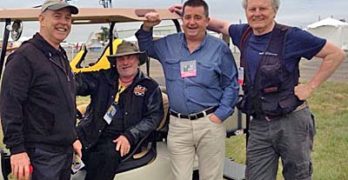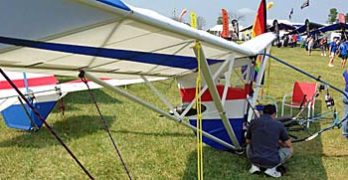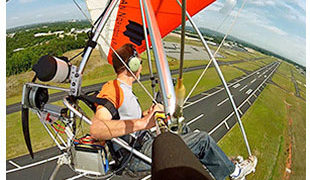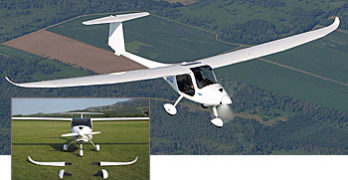The Top 50 video series has gone over very well and continues with this post about the Phoenix LSA motorglider. If you thought it disappeared and were unhappy about that, have I got good news for you!
I am aware of a very positive development regarding Phoenix that I am working to confirm. As soon as I have fuller details I will update this article but the prospects for LSA motorglider look promising.
In North America, Phoenix Air USA is run by Ed Babovec (email) and he is excited about 2024. …more as it unfolds.
Motorgliders as a subset of all aircraft enjoy some very special privileges that endear them to the recreational flying community. In particular, motorgliders do not require an aviation medical. That alone makes them desirable but long-gliding capabilities make them safer to some pilots and simply more enjoyable to others. Let’s look a little more deeply.
Keeping Aircraft Affordable, Blue Collar Aviation Has a Flying Machine for Everyman
Tabor Coates calls his business Blue Collar Aviation. Honestly, as someone who scours the globe for affordable aircraft, any business with this name was certain to grab my attention.
This isn’t simply adroit marketing. Tabor’s Maynard, Massachusetts operation is deep into affordable aviation. How affordable? Tabor’s most-expensive offering is the SkyRanger Nynja (featured in this 2023 article and this flight report). With every item needed in the kit to include engine, instruments and coverings that need no paint, this tried-and-true light aircraft sells for $65,000 and that even includes freight from across the Atlantic.*
How deep into affordable goes Tabor? He offers two versions of SkyRanger — Swift III and Nynja — with a complete kit for the former starting at $49,985. If that’s still high for your budget Tabor offers FlyLight’s line of superlight (nanolight?) weight-shift trikes. The simplest of these flying machines are ready-to-fly for around $15,000.
Innovative, Versatile Merlin — a Video Series You Loved (because?) It’s Affordable
This Merlin has nothing to do with kids in colorful costumes seeking sweets from their neighbors. It does have to do with pilots liking interesting airplanes that they can fly over their neighbors… especially when they can afford the airplane.
In the last couple years, I’ve created videos with Merlin developer, Chip Erwin that have been among the most-watched on Dave Loveman‘s Light Sport and Ultralight Flyer YouTube channel. I interviewed numerous industry leaders like Chip in around 1,000 videos. The 50 most popular of those productions have been watched more than 10 million times.
In addition, when I write about Merlin on this website, lots of readers seem to love it.
So it’s hardly any wonder that I would be pleased to continue our Top 50 video series with one from just a couple of years ago. In a short time, it passed the 275,000-views mark. Since then, I did another on Merlin that went over well on my own channel (see below).
A Song to Lift Your Spirits — Clever, Sleek, and Part 103-Capable from Future Vehicles
You know this airplane and you know this company, although a refresher might be in order.
You can be excused if this one slips you mind. The airplane in the nearby images was from years ago when you probably first saw it with an electric motor developed by Randall Fishman, one of the original pioneers in the electric aircraft space.
He was so far ahead of his time that a market for electric had yet to develop. When Randall flew his first battery-electric-powered trike 16 years ago at Oshkosh 2007, no one was using the terms “air taxi” or “multicopter.”
Electric Aircraft Corporation didn’t complete many sales but Randall’s developments were ground-breaking.
Now the handsome Song returns with a new producer, Future Vehicles. Earlier I wrote about the charming biplane Dingo, a modern-day follow-on to Hovey’s Whing Ding and worthy entry in the Part 103 space.
Super-Efficient Electric Flight — Ego Trike with ATOS Wing Shows How E-Propulsion Works Today!
From dawn to dusk, we hear how electric propulsion is going to save the Earth. Whatever your belief about the hazards of fossil fuel, electric propulsion is coming. When is another matter.
Air taxi ventures based on multicopter designs are drinking up funds by the tens or hundreds millions of dollars, probably billions by now. I don’t have a shred of doubt that these will lead to genuine changes in transportation… but I would not hold my breath until such services become common. I suspect it will be many years yet.
However, today, electric propulsion for ultralight aircraft works quite well, especially when it serves a purpose. For soaring pilots, power is about getting to altitude where they can explore ridge, thermal, or wave lift. Those who love such flying, like me, seek out the best machine that might deliver that capability. Ultralight Design’s Ego trike can.
High-Tech Composite
Anyone who knows hang glider wings will admire both the construction and substantially higher performance of what’s called a rigid wing — more common hang gliders are called flex wings.
Glowfly Update; Clever Name—Clever Project
What’s in a name? I like Glowfly, as a sort of double entendre. It could suggest “Go fly,” or it might refer to glow as in the spark employed to start a turbine engine. Yup, in case you didn’t see our earlier article by Dave Unwin, the newly renamed Glowfly is a jet-powered sailplane that uses electric-powered main wheel propulsion to assist. How’s that for — as my favorite British comedy troupe, Monty Python, used to say — “something completely different?”
Formerly called GloW (which nearly everyone was sure to misspell; certainly your smarty-pants smartphone would never get the capitalization right), Glowfly is moving along smartly. Here’s an update the folks at ProAirport sent along.
“The first public reveal — Project Glow becomes Glowfly,” glowed the ProAirport team.
In the last weekend of November at the Flyer Live show, ProAirport said, “We were overwhelmed by the number of visitors to the ProAirsport stand. It was truly fantastic to meet and talk to all these extremely interested people who had made a beeline for us after hearing and reading all about Project Glow [the project’s earlier name].” They reported that many interested pilots specifically came to see Glowfly live, as the show name suggests.
Boeing & Airbus Explore Light Aircraft
Recently I had a visit from my longtime friend and fellow aviation journalist, James Lawrence (photo). Among other mutual interests we share a passion for electric aircraft. We’ve each flown early examples and believe we see the future. From the headline above, you might interpret that to mean we anticipate electric airliners. We might … yet we recognize such developments remain distant. Or, do they?
The electric power action today is in very light aircraft — and some are available for you to buy and fly immediately. One example is Zigolo and I’ve reported on eSpyder. The reason is that light aircraft rule is singular: batteries, which weigh too much to allow heavier aircraft any range. The ending video explains why.
Unless you’ve been off-planet for a while, you know the development of improved battery technology is drawing many billions of dollars of investment. Cars, laptops, drones and many more products or industries want better batteries.
Affordable EMG … Electric Motor Glider
Update 8/8/14 — See our video interview about EMG at the end. An unpowered EMG — or Electric Motor Glider — from Adventure Aircraft has already taken 400 flights; it has also been fitted with a small electric motor … complete with carbon folding prop. A new Experimental Amateur Built (EAB) two seater is now taking shape and both variations were on exhibit at AirVenture 2014 in the newly named Fun Fly Zone (formerly Ultralight Area). EMG’s spark is provided by the dynamic duo of Brian and Carol Carpenter of Rainbow Aviation, well known for their LSA maintenance courses including the LSR-M (Light-Sport Repairman Maintenance) credential that has prepared many mechanics to do serious work on the growing fleet of LSA. EMG builder Adventure Aircraft is a subsidiary of Rainbow. Evidently this hard working pair aren’t fond of wasting many hours with something so mundane as sleep because the project is unfolding quite swiftly.
Electric Trike Soars (Literally) into Record Book
On Saturday, June 21 with a good crowd watching, an electric-powered trike took off and climbed into the FAI record book, or will after the organization’s normal process is followed. Let me state right up front that this story was recently released on AOPA’s ePilot written by our journalist friend Jim Moore. Despite appearing in the big member organization’s eNewsletter, the story was too cool for me to pass up for ByDanJohnson.com plus, as usual, I have an additional perspective to offer. The images are all courtesy of record-holder-to-be, Gary Davis. If you click the link above you can read Jim’s whole article; I encourage you to do so.
As Jim wrote Gary flipped the switch and flew, “a custom combination of a North Wing Stratus trike wing matched to an electric-powered trike frame designed by Randall Fishman.” We have a number of articles and videos about Randall’s pioneering work.
Pipistrel’s Flexible Sinus & Soarable Taurus
After Germany’s Aero 2013 event, we traveled to Pipistrel. It was our first visit to Slovenia, a country of four million with a section of the Alps running through it and a lovely route called the Emerald Trail to view the tall mountains. Slovenia proved a beautiful country that we’d love to visit again, but a leading reason to repeat is the presence of Pipistrel. This summer, the LSA and self-launched glider producer is in the news with their exchangeable wingtip Sinus Flex that transforms the long, shapely motorglider wings from a 50-foot span to a more hangar-manageable 40 feet. Using a single bolt, the change is said to take only five minutes and the unused tips can be stored in leather bags; the option price is $5,200. Buyers get both “a long range super-economic cruiser” and a “training aircraft,” noted Pipistrel. Sinus offers dual flight controls and a choice of either tailwheel or nosewheel gear, though the latter decision must be made at purchase.


